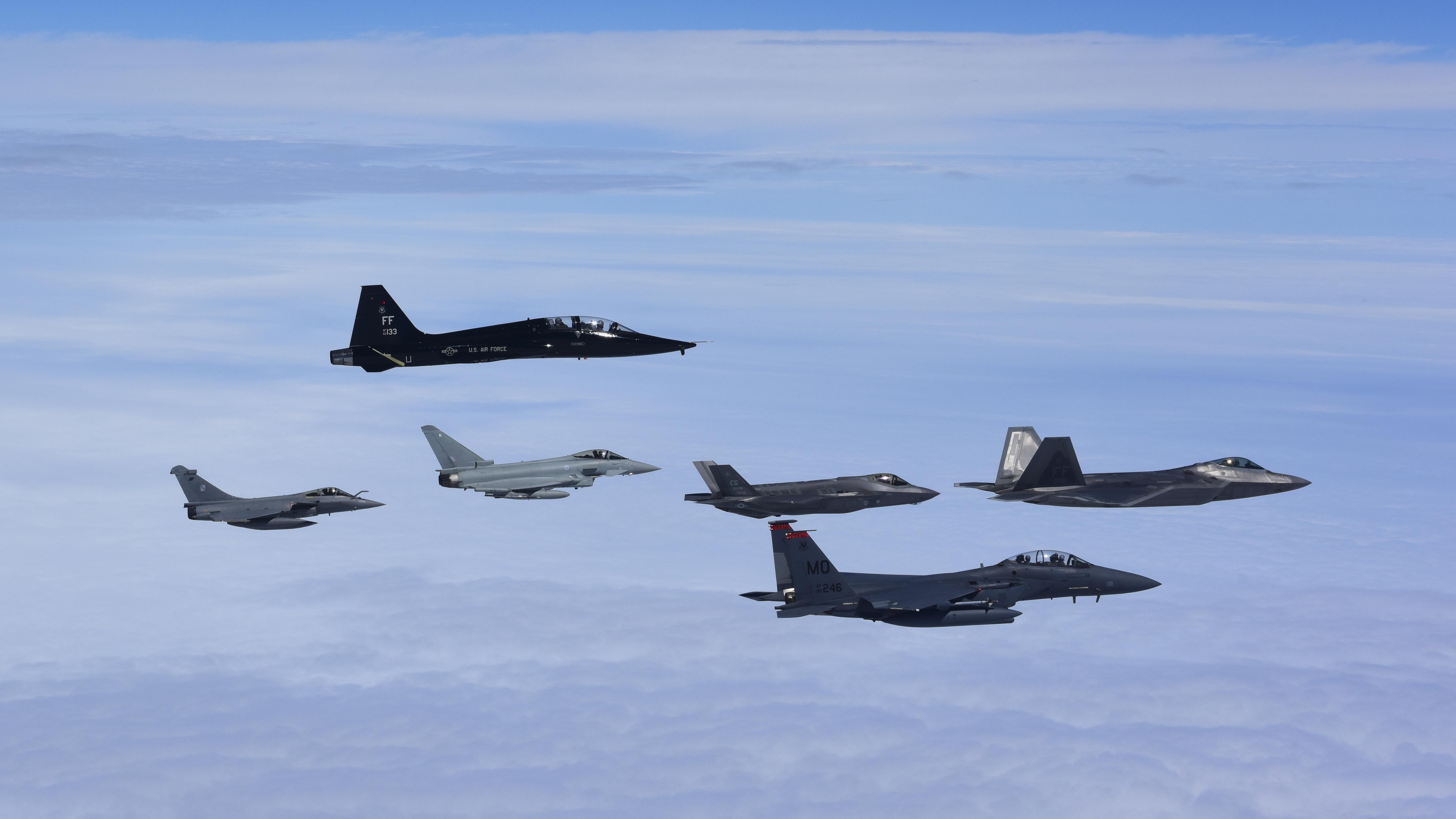US Air Force, French air force, and Royal Air Force fly in formation during Atlantic Trident 17 near JB Langley-Eustis, Va., April 26, 2017. USAF photo by SSgt. Natasha Stannard.
JB Langley-Eustis, Va. The Air Force’s fifth generation F-22s and F-35s flew alongside the best British and French fighters for the first time in a large-scale exercise here, but the aircraft is not the focus of the event.
For USAF commanders planning and flying regularly in Exercise Atlantic Trident 2017, the pilots and maintainers themselves are the important focus of the trilateral exercise.
“There’s been a lot of interest in the machines. Which airplane is better? What are their capabilities? How are you using them?” Col. Peter Fesler, commander of Langley’s 1st Fighter Wing, told Air Force Magazine on April 27 as the exercise wound down. “The thing I think is particularly interesting, the man in the machine matters tremendously. You can have the most capable aircraft in the world, but with a pilot who can’t perform, he will be beat. That’s why training matters, it’s why we have to do things like [this exercise]. You can’t just buy airpower.”
Atlantic Trident first began in December 2015, with Eurofighter Typhoons from the UK and French Dassault Rafales flying alongside F-22s at Langley. The inaugural effort focused more on deploying the aircraft and focusing on how they could bed down and operate at a new base. This time around, however, the aircraft built on that corporate knowledge and immediately jumped into training.
And this time, USAF F-35As from Eglin AFB, Fla., joined in.
Over the course of three weeks, USAF F-22s and F-35s flew alongside Eurofighters and Typhoons against USAF F-15Es from Mountain Home AFB, Idaho, and T-38s at Langley acting as “red air.” The first week focused on basic fighter maneuvers, the second on defensive counter air operations, and the third on offensive counter air.
F-22s and F-35s used stealth and advanced sensors to coordinate the speed and firepower of the Eurofighters and Rafales in combat against F-15Es and T-38s that had to develop different tactics to take on the advanced aircraft, said Lt. Col. Brad Bashore, commander of the 58th Fighter Squadron at Eglin.
“Sometimes sheer numbers are more important than the actual technological capabilities of that airframe,” Bashore said.
T-38s are “sneaky” and able to get closer, while F-15Es used their sensors to try to track the adversaries from distance.
“A big way to challenge fifth generation aircraft is to give you numbers, you put a lot of aircraft in the air,” Fesler said, adding that makes F-22 pilots plan better because of their limited number of weapons. “You can run Raptors out of munitions, and make pilots have to work.”
Eglin’s F-35s were called to participate in the exercise because the Air Force’s only operational F-35s, assigned to Hill AFB, Utah, were busy, on the first deployment to Europe. The intense exercise helped the squadron’s instructor pilots better understand the capabilities and limitations of their aircraft and in turn improve their ability to teach new F-35 pilots.
Eglin’s F-35s are flying on the Block 2B software suite, which is more limited compared to the Block 3i suite on Hill’s F-35s. The jets were limited to Mach 1.6, 50 degree angle of attack, and 7Gs, however the F-35s were still able to use stealth and sensors to make a difference, Bashore said.
But the jets themselves don’t tell the whole story of the three-week exercise.
“All these aircraft have tremendous capabilities, but if we don’t plan them and integrate them and understand each other’s capabilities and limitations, and use them to th?eir full potential, then we could lose in any combat scenario,” Bashore said. “It’s more about the human element.”
